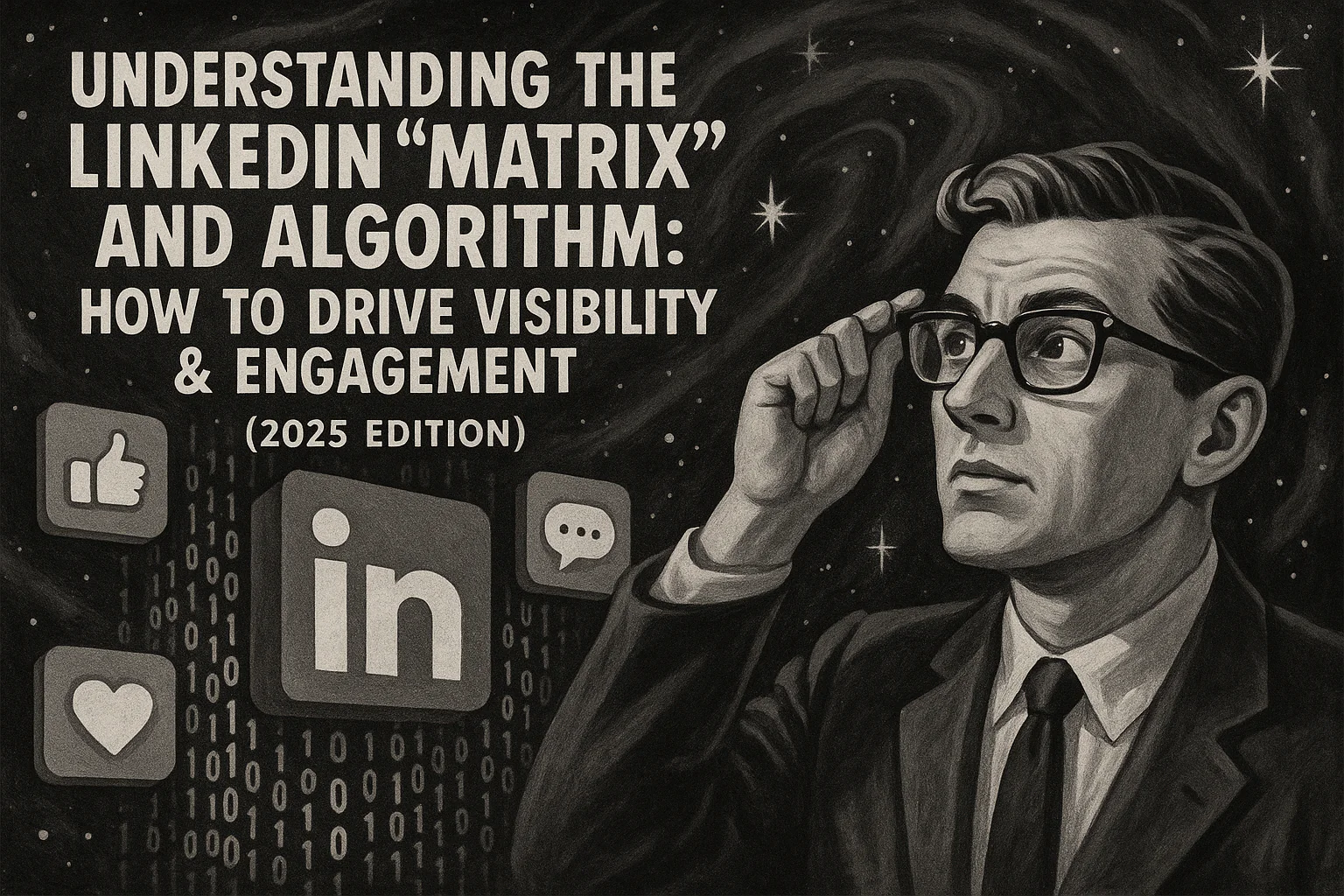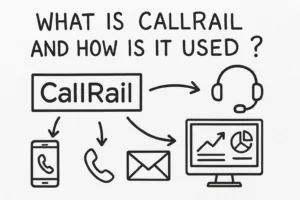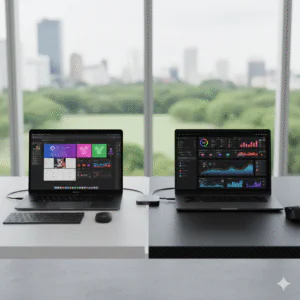What We’ll Cover in This Article: Understanding the LinkedIn “Matrix” and Algorithm
- How LinkedIn’s algorithm really works (beyond surface rules)
- Why the size and shape of your network does matter—and how to make it matter positively
- Tactical posting strategies: format, timing, interaction, and content types
- The anatomy of engagement and how to unlock reach
- How to future-proof your LinkedIn presence amid algorithm shifts
Who This Is For
You’re a B2B marketer, thought leader, or content owner (e.g. in professional services, tech, or agency work) who wants your LinkedIn posts to actually reach the right people, not just drift into feed oblivion. You’ve tried posting often, but results have been inconsistent. You want clarity—not platitudes—on what works, what doesn’t, and why.
This is a Consideration/Decision stage piece: by the end, you should be able to test or refine your LinkedIn strategy with higher confidence.
The Big Concept: The LinkedIn “Matrix”
When I refer to the LinkedIn “matrix,” I’m talking about the implicit network + content + algorithm interactions that determine whether a post is seen, engaged with, or buried. Unlike purely chronological or purely interest-based feeds, LinkedIn operates in a hybrid space:
- It starts with your first-degree connections
- It then uses signals to expand into second and third-degree reach
- It embeds graph embeddings/similarity metrics to connect your content to users who aren’t obviously linked—but whose interests align
- It always layers in quality filters (spam, low-effort posts) at the front end
So your job as a content creator is to insert yourself—your content and your network—into that matrix in such a way that the system wants to surface you, rather than suppress you.
Let’s unpack how each axis of that matrix really works.
1. The Algorithm, in Three Phases
Many articles simplify LinkedIn’s algorithm into three steps: quality filtering → engagement test → wider distribution. That’s accurate as a map, but let’s go deeper with the latest insights.
| Phase | What Happens | What Signals Matter | How You Influence It |
|---|---|---|---|
| Quality Filtering / Spam Check | The system quickly checks whether your post violates policies or is flagged as “low quality” | Use of too many hashtags, self-promotion, misleading tags, and overly frequent posting | Avoid clickbait framing; limit to 3–5 relevant hashtags; avoid posting <12 hours apart. |
| Engagement Test (Initial Probe) | Your post is shown to a small subset of your first-degree network to see how it performs | Velocity (how fast likes/comments arrive), dwell time, “see more” clicks, quality of comments | Publish when your network is active, reply quickly to early comments, stimulate discussion with a comment prompt |
| Extended & Graph-based Distribution | If the post “passes,” LinkedIn may show it to second-/third-degree users or through embedding-based retrieval | Signal strength from initial engagement; profile-topic similarity; embedding proximity; profiles of early engagers | Build topical consistency (signals), encourage engagement from relevant profiles, optimize your profile for target audience relevance |
A recent TrustInsights “Unofficial LinkedIn Algorithm Guide 2025” emphasizes that Embedding-Based Retrieval (EBR) is a powerful hidden lever: the system embeds both users and posts in vector space, and surfaces content whose embedding is “close” to the user’s embedding—even if there is no direct connection.
Pro Tip (Doceo): If your content and profile signals map to the “neighborhood” of your target audience (skills, topics, keywords), embedding retrieval increases the chance they’ll see your post even without direct connections. Don’t let your content live in a silo.
2. Why Network Size (and Shape) Still Matters
It’s tempting to believe “bigger is always better” when it comes to LinkedIn networks. But in 2025, the reality is more nuanced.
a) Quality over quantity
- A recent commentary observed that accounts in the 500–999 connections range often outperform very large networks in terms of relative engagement—because their network is tighter, more relevant, and more active.
- With a 10,000+ connection network, many links may be weak ties, dormant accounts, or unengaged users. The algorithm may discount those signals.
b) Graph structure and embedding advantage
- Because LinkedIn’s algorithm leverages graph neural networks and embedding similarity, how your connections relate to one another matters. It’s better to have clusters of relevant, active people than a flat, massive list.
- The early step of “Candidate Generation” pulls from first-, second-, and third-degree connections, but also relies on graph structure (who is connected to whom).
- In effect: if your connections are well-aligned with your target profile cluster, your content is more likely to be surfaced via embedding-based matching.
c) Engagement from high-value nodes
- The algorithm also looks not just at how many engaged, but which engaged. If thought leaders or highly connected people comment, those signals carry more weight.
- For example, if someone in your second-degree cluster engages and is seen as a “bridge” node in the network, that can amplify distribution further.
d) Network “decay” and pruning
- Over time, inactive or irrelevant connections dilute your “engagement potential.” Some creators routinely prune or archive connections to keep their network “tight.”
- Because LinkedIn signals trust based partly on prior engagement history, having fewer but higher-quality, active relationships may help more long term.
Pro Tip (Doceo): Don’t go for raw connection numbers. Go for strategic expansion. A useful exercise: review your pending connection requests—accept those who fit your target clusters or whose content you already value, and ignore or reject the rest.
3. What’s a “Good Post” in 2025 — Format, Length & Content Types
To beat the algorithm, your content has to check multiple boxes. Let’s break them down.
3.1 Post length and structure
- Extremely short posts (< 100 words) often get classified as low-effort unless they trigger strong early engagement.
- Posts in the 300–800 word range tend to hit the sweet spot: enough depth to provoke meaningful discussion, but not so long as to push readers away.
- But length isn’t a substitute for structure. Break your post into digestible chunks with line breaks, headings, and “See More” hooks in the first ~140 characters (the preview zone) to entice more click-through.
3.2 Formats that tend to outperform
| Format | Why It Works | Caveats / Best Use |
|---|---|---|
| Text + Document/Carousel slides | Allows you to tell a fuller story with evidence or visuals — carousels get people to swipe and linger | Ensure each slide is tightly focused; don’t overload |
| Native video (60–90 seconds ideal) | More dwell time, autoplay, and immediate value tend to signal quality to the algorithm | Hook in first 3–5 seconds; optimize for mobile |
| Long-form articles (LinkedIn Articles/newsletters) | Good for deeper thought leadership; can be surfaced in external search and internal LinkedIn searches | Only publish when the content is strong, because it costs more “attention capital” |
| Polls/question posts | Good for sparking light engagement, especially to feed into conversations | Use sparingly; avoid low-effort polls (“Which do you like more?”) that don’t drive depth |
3.3 Content types that perform well
- Industry insights, trend analysis, counterintuitive takes — because LinkedIn is biased toward expert content.
- Narrative + lessons learned — stories help bring technical or abstract ideas down to human scale
- Data, frameworks, models — people on LinkedIn like to reference things they can “borrow”
- Calls for discussion, not just likes — e.g. “In your experience, what’s changed?”
- Stable mix of evergreen and topical content — topical anchors engagement spikes; evergreen builds long-term authority
Pro Tip (Doceo): Use a 70/30 rule — 70% insight-driven content (your area of expertise), 30% trending or “hot take” content to capture attention and current relevance.
4. Timing, Engagement, and “Golden Hours”
a) Timing strategy
- Post when your core audience is active — that varies by industry and geography. Test windows like 8–10 AM and 12–2 PM on weekdays.
- Some creators double-post (morning + late afternoon) to capture disparate time zones, but avoid posting too frequently (< 12 hours apart).
- LinkedIn tends to give posts ~24–48 hours of prime visibility; after that, unless comments keep trickling in, the ranking decays.
b) Engagement velocity and reply strategy
- The first 60 minutes (or first 1–2 hours) are critical. High engagement in that window can cause the algorithm to push your post further.
- If a post “takes off,” comments may continue surfacing it for days or weeks.
- Replying thoughtfully to each comment helps. It shows active discussion and helps “lift” the post’s score in real time.
- Proactively comment on other people’s posts (especially those in your target cluster) 20–30 minutes after posting; that activity “signals presence” and encourages reciprocal visibility.
c) Encouraging the right engagement
Not all engagement is treated equally. The algorithm rewards meaningful interaction — full thoughtful comments, replies, continued back-and-forth, and dwell time. Reactions or one-word comments have far less weight.
Avoid gimmicks like “tag 5 friends for reach,” which the algorithm may now penalize.
Pro Tip (Doceo): Build a “first-responder list” — people in your network you can count on to comment quickly. Use reciprocal commenting (not a pod) to boost early engagement naturally.
5. Signal Reinforcement: How to Build Algorithmic Trust
Posting once and hoping for the best is not a sustainable approach. You need to reinforce signals over time.
a) Topical persistence
- Focus on 2–4 verticals or themes in your content. That consistency signals to the LinkedIn algorithm that you are an “authority” in those areas.
- Avoid switching topics too often; you want your “content fingerprint” to become well-defined.
b) Profile alignment
- Your headline, about section, skills, and endorsements should align with your content domain. That strengthens the embedding similarity match.
- If someone sees a post from you, they should see profile consistency that says: “Yes, this person should write about this topic.”
- Keep your interests, hashtags you follow, posts you engage with, and comments aligned with your target cluster.
c) Cumulative performance
- LinkedIn gives more leeway to creators whose past content performed well. That means early wins help unlock reach for later posts.
- That also means you should treat lower-performing posts as experiments—not disasters. Analyze, tweak, and iterate.
d) Avoid algorithm risks
- Avoid frequent use of external links in the main post (if possible, put links in comments).
- Avoid repetitive posting of the same text or overuse of copy-paste templates.
- Don’t over-tag or mention irrelevant accounts (spammy behavior is filtered).
- Avoid platform gaming (pods, engagement swaps) that feel inorganic — LinkedIn is getting better at filtering those.
6. Hypothetical Example: A Thoughtful Series That Breaks Through
Let’s walk through a hypothetical:
- Week 1 Post: “Why most B2B marketers ignore LinkedIn’s hidden ranking rules (and what they miss).”
- ~550 words, data + mini-framework, ending with a question: “What surprising metric changed your reach recently?”
- Posted at 9 AM on Tuesday.
- A few trusted colleagues comment early. Others reply, you respond. It gains traction.
- Week 2 Post: “How embedding-based retrieval may be surfacing your content to users you didn’t connect with.”
- Deep dive into graph embeddings, using a metaphoric example.
- You reference signs (e.g. “I got a message from someone who never saw me before…”)
- You tag 1–2 relevant authors (with permission), but sparingly.
- Supporting Activity:
- You comment on posts from industry peers that connect to your topics.
- You message 5 new connection prospects (relevant to your cluster), referencing your recent posts.
- You refine your profile to emphasize the topics you’re posting about.
Over 3–4 posts, you begin to see more reach—even outside your first-degree network. The algorithm starts “trusting” your posts and embedding proximity helps bring in relevant users.
Then, in Week 4, you drop a short video or carousel summarizing lessons learned. That helps capture bite-sized engagement and invites new viewers into your more text-heavy posts.
If done well, you’ll gradually escape the “algorithm drift” trap (where your content gets confined to your immediate circle) and enter a virtuous feedback loop of reach → engagement → reach.
7. What to Test & Track
You can’t optimize what you don’t measure. Here’s a quick testing framework:
| Metric | Why It Matters | Benchmark / Target | Action If Low |
|---|---|---|---|
| First-hour engagement | Signals early traction to the algorithm | Aim for 3–5 comments, replies, or quality interaction within 60 mins | Pre-alert your network, ensure you’re active to reply |
| Dwell time / “see more” clicks | Indicates users are reading more, not skipping | > 35–40% click “See More” on long posts | Improve hook, tighten intro, break into smaller paragraphs |
| Comment ratio (vs likes) | Comments are more valued than passive reactions | At least 40–60% | |
| of interactions should be comments or replies | Ask a provocative question; invite discussion | ||
| Reach to 2nd/3rd degree | Shows expansion beyond your immediate network | Growth in impressions outside your circle | Post content aligned with embedding similarity |
| Follower/connection growth | Reflects new interest in your voice | 5–10% bump over a month | Add CTA to follow/subscribe; engage inbound commenters |
Doceo Pro Tip: Maintain a running spreadsheet of your posts with metrics, topic tags, formats, times. Over a quarter, cluster by “winning themes” and “losing themes” — then double down.
8. Algorithm Pitfalls & Shifts to Watch
Even the best strategy can be blindsided by LinkedIn changes. Here are a few red flags and shifts to monitor:
- LinkedIn may increase weighting on dwell time or video completion rate — prioritize content that holds attention.
- The platform is increasingly punitive toward engagement bait (e.g. “comment YES” prompts).
- Embedding/graph models may evolve, meaning new signal features (e.g. cross-domain features) will rise in importance. (For example, LinkedIn recently published a paper using cross-domain GNNs for notification personalization, implying their infrastructure is deeply embedding multi-signal models across content, users, and activity. )
- Platform-level changes (feed logic, notification weighting) can shift post decay curves.
- If you’ve enjoyed a “free-ride” from high reach accounts (e.g. a viral post), don’t assume that sustains—continue reinforcing your own signal independence.
FAQ
How often should I post?
Aim for 3–5 posts/week (spread across formats). Consistency matters more than volume, as long as quality remains strong.
Should I use a scheduled tool?
Yes, but schedule only when you can be present (at least within first hour). Auto-posting without engagement risks your posts losing momentum.
Can I reshare old content?
With caution. If you reshare, update it (fresh hook, new insight, updated data). Let the algorithm treat it as new. Avoid blind reposts.
What about hashtags—how many and which?
Stick to 3–5, combining niche (industry) and broader (e.g., #B2B, #Leadership). Use ones your target audience already follows.
When do I know a post has “died”?
If after 48 hours you’re seeing zero new engagements and impressions flatten, the algorithm has likely de-ranked it.
Final Thoughts
The “LinkedIn matrix” is not a magical black box. It’s a system of signals—network structure, content signals, embedding proximity, and engagement history. Your job is to become signal-worthy in the eyes of the algorithm and in the eyes of your ideal audience.
Success on LinkedIn today isn’t about hacks. It’s about discipline, signal alignment, and strategic content. If you can thread those together—intelligently growing your network, consistently producing high-value content, and engaging thoughtfully—you position yourself not just to be seen, but to be trusted.
📈 Ready to Elevate Your LinkedIn as a Lead Engine?
At Doceo, our Marketing Services Division help B2B firms build content systems and personal branding engines so your LinkedIn doesn’t just generate likes—but generates new opportunities. Let’s talk about how to architect your LinkedIn presence as a trusted pipeline.
👋 Want to map a 90-day LinkedIn content plan or audit your profile for algorithm fit? Talk to our experts today: LET'S TALK





